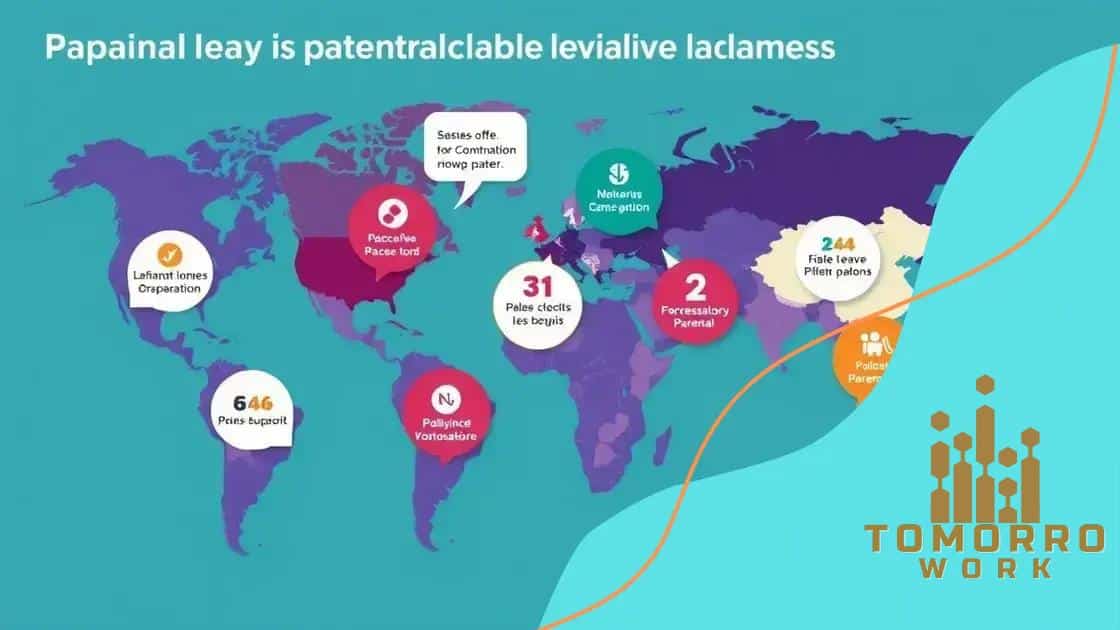How paid parental leave is evolving in the U.S.

Advertisements
Paid parental leave in the U.S. is evolving towards more inclusive and flexible policies that enhance family support, employee satisfaction, and align with global standards for parental leave.
How paid parental leave is evolving in the U.S. is crucial for families navigating parenting and work-life balance. You might be wondering, how have these policies changed recently?
Advertisements
Understanding paid parental leave policies
Understanding paid parental leave policies is essential for working parents today. These policies provide support during one of life’s most significant transitions: welcoming a new child. Many people are curious about how these leave policies work and why they are critical for families.
Paid parental leave policies can vary greatly from one state to another or even between companies. It’s crucial to recognize that parental leave is not just a benefit; it can significantly affect family well-being and workplace dynamics. Knowing the details can help parents prepare for their leave and return to work.
Types of Paid Parental Leave
Often, paid parental leave comes in a few different forms. Here are the most common:
Advertisements
- Birth Leave: Offered to parents who give birth to a child.
- Adoption Leave: Available for parents who adopt a child.
- Foster Care Leave: Designed for those who take in children through foster care.
Each type of leave serves a vital role in supporting families during significant life changes. Parents should check if their employer offers these types of leave and understand the duration and pay structure associated with each.
Key Benefits of Paid Parental Leave
Paid parental leave offers numerous benefits beyond the immediate support for new parents. Consider these important points:
- Improved mental health for parents, as financial stress is reduced.
- Stronger family bonds, as parents can spend crucial time with their new child.
- Better workplace morale, as employees feel valued and supported by their employers.
By understanding these policies and their impacts, parents can make informed decisions and advocate for better leave options when necessary. As more states and companies recognize the importance of supportive leave policies, the landscape is continually evolving.
The impact of paid leave on families
The impact of paid leave on families is profound and multifaceted. Having access to paid leave transforms the early days after a child is born or adopted. It allows parents to bond with their new child without the stress of financial concerns.
When parents can take time off work, they can focus on nurturing and caring for their newborns. This important phase helps in forming strong emotional connections. Moreover, studies show that this time can reduce incidents of postpartum depression among new mothers, leading to healthier family dynamics.
Benefits for the Family Unit
Paid leave not only supports individual parents but also strengthens the family as a whole. Here are some notable benefits:
- Stronger emotional bonds: Spending quality time together fosters close relationships.
- Shared responsibilities: Parents can equally share child-rearing duties during the early months.
- Improved health outcomes: Children benefit from increased attention and nurture during their crucial early development.
As parents have the opportunity to bond and adjust to their new roles, the home environment becomes more stable and nurturing. This stability is crucial for a child’s development during those formative years.
Economic and Social Effects
The economic implications can also be significant. Families with paid leave are less likely to face financial stress during this critical time. When parents can take time off without worrying about lost wages, they often experience reduced anxiety, leading to better overall well-being.
Additionally, the social impact is noteworthy. Paid leave policies promote gender equality by allowing both mothers and fathers to participate equally in the early upbringing of their children. This shared responsibility can lead to more equitable divisions of labor at home and at work.
Comparative analysis with global standards

Comparative analysis with global standards reveals the diversity and progress of paid parental leave policies around the world. Each country has different cultural and legal perspectives on parental leave, leading to varied practices and benefits.
In many countries, parental leave is a well-established right. For instance, in Sweden, parents enjoy up to 480 days of paid leave that can be shared between both parents. This policy encourages fathers to take time off and engage in early childcare, leading to more balanced family dynamics.
Examples of International Policies
Several nations have implemented progressive parental leave policies that stand out:
- Norway: Offers 49 weeks at full pay or 59 weeks at 80% pay, promoting equal sharing of leave.
- Germany: Allows up to 14 months of paid leave, which can be shared by both parents, enhancing family involvement.
- Canada: Provides flexible leave options, allowing parents to choose between longer leave at lower pay or shorter leave at higher pay.
The variety of policies demonstrates that countries prioritize family support differently based on their values and economic capabilities. The way these nations structure parental leave greatly influences parents’ choices about work and family life.
The U.S. Context
In contrast, the United States lacks a federal mandate for paid parental leave. This absence leads to a patchwork of state laws and company policies that can vary widely. While some employers offer robust paid leave options, others provide minimal to no leave at all. As more discussions around paid parental leave occur, comparing with global standards highlights the need for reform in the U.S.
Understanding these international benchmarks can give insights into what the U.S. might aspire toward in creating a more equitable and supportive environment for families. The benefits seen in nations with stronger family policies can encourage U.S. policymakers to consider changes that support working families.
How companies are adapting to changes
How companies are adapting to changes in paid parental leave policies reflects a growing understanding of employee needs and the importance of family support. Many organizations are reevaluating their leave policies to attract and retain top talent.
As the conversation around parental leave evolves, companies are recognizing that flexible and generous leave policies can enhance employee satisfaction. This realization has led to innovative strategies in accommodating the diverse needs of their workforce.
Customized Leave Options
Companies are increasingly offering customized leave options that address the specific needs of their employees. Some of the adaptations include:
- Flexible leave durations: Employees can choose the length of their leave based on their family’s requirements.
- Part-time return options: Gradual reintegration into work allows parents to transition back at their own pace.
- Inclusive policies: Recognizing diverse family structures by supporting adoptive and foster parents.
These changes foster a more supportive environment for parents, contributing to a positive company culture. By understanding the varied dynamics of family life, businesses can create a culture of inclusivity and support.
The Role of Technology
Technology also plays a crucial role in how companies adapt their parental leave policies. Many organizations adopt technology-driven solutions to streamline the process of applying for and managing leave. Online portals and apps make it easier for employees to understand their options and track their benefits.
Moreover, companies use data analytics to monitor employee feedback and policy effectiveness. Understanding the needs of their workforce allows them to adjust their programs continually. This responsive approach not only meets the expectations of employees but also enhances retention rates and overall job satisfaction.
Future trends in parental leave legislation
Future trends in parental leave legislation are becoming a critical topic as society continues to evolve. As more employees advocate for their needs, companies and governments are starting to respond.
In recent years, several trends have emerged that indicate where parental leave legislation may head in the future. One major trend is the push for expanded maternity and paternity leave. Many advocates are calling for longer leave periods to allow parents more time to adjust to their new roles.
Increased Flexibility
Flexibility is another growing requirement among working families. Parents desire options that fit their unique needs. This shift could lead to:
- Job-sharing arrangements: Allowing two employees to share responsibilities during leave.
- Phased returns: Enabling parents to gradually return to full-time work.
- Remote work possibilities: Allowing parents to work from home during the transition.
As more companies recognize the value of flexibility, we can expect an increase in initiatives that support diverse family needs, helping to create a more inclusive workplace.
Legislative Changes
On a larger scale, potential legislative changes may also take shape. Countries around the world are observing successful parental leave models, creating pressure for U.S. policymakers to consider more comprehensive federal policies. These changes could include mandatory paid leave or improved job protection for parents taking leave.
Data and personal stories highlighting the impacts of generous parental leave are crucial in pushing for change. The experiences of parents who have benefitted from such policies can provide a compelling argument for expanding leave options.
Finally, as the workforce becomes more diverse, legislation may reflect a broader understanding of family structures. More inclusive policies can help support not only biological parents but also adoptive and foster parents as well.
FAQ – Frequently Asked Questions about Paid Parental Leave in the U.S.
What is paid parental leave?
Paid parental leave is a policy that allows parents to take time off work while receiving pay during the period after the birth or adoption of a child.
How does paid parental leave benefit families?
It allows parents to bond with their new child, reduces financial stress, and can improve mental health and family relationships.
Are there any laws mandating paid parental leave in the U.S.?
Currently, there is no federal mandate for paid parental leave in the U.S., leading to varying policies by states and employers.
What trends are shaping the future of parental leave legislation?
Trends include increased flexibility in leave options, longer leave durations, and a push for inclusivity in policies to support diverse families.





